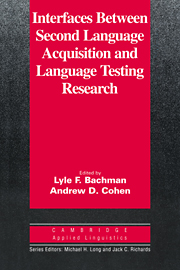Book contents
- Frontmatter
- Contents
- List of contributors
- Series editors' preface
- Preface
- Chapter 1 Language testing – SLA interfaces: An update
- Chapter 2 Construct definition and validity inquiry in SLA research
- Chapter 3 Research on interlanguage variation: Implications for language testing
- Chapter 4 Strategies and processes in test taking and SLA
- Chapter 5 Describing language development? Rating scales and SLA
- Chapter 6 Testing methods in context-based second language research
- Chapter 7 How can language testing and SLA benefit from each other? The case of discourse
- Appendix: Language testing – SLA research interfaces
- Index
Chapter 7 - How can language testing and SLA benefit from each other? The case of discourse
Published online by Cambridge University Press: 05 October 2012
- Frontmatter
- Contents
- List of contributors
- Series editors' preface
- Preface
- Chapter 1 Language testing – SLA interfaces: An update
- Chapter 2 Construct definition and validity inquiry in SLA research
- Chapter 3 Research on interlanguage variation: Implications for language testing
- Chapter 4 Strategies and processes in test taking and SLA
- Chapter 5 Describing language development? Rating scales and SLA
- Chapter 6 Testing methods in context-based second language research
- Chapter 7 How can language testing and SLA benefit from each other? The case of discourse
- Appendix: Language testing – SLA research interfaces
- Index
Summary
Second language acquisition (SLA) and second language testing (LT) both focus on “what” and “how” issues of language: SLA is concerned with what the learner's language is at a given point and how further language can best be acquired, and LT is concerned with what language ability (knowledge) is and how it can best be measured. This chapter examines the extent to which each discipline can benefit from advances made in the other, using the example of discourse. It begins by focusing on the contribution of LT to SLA, with emphasis on the following areas: (a) defining the construct of language ability, (b) applying findings from LT to confirm and/or test SLA hypotheses, and (c) providing SLA researchers with quality criteria for tests and tasks. We then turn to the contribution of SLA to LT, focusing on: (a) identifying the language components that need to be elicited, (b) proposing innovative tasks that can be used for language assessment, and (c) informing language testers about language variations so tests can be constructed accordingly. Each of these contributions is discussed using the case of discourse.
Contributions of LT to SLA
Defining the construct of language ability
While SLA researchers have focused on the description of the learner's language, language testers have concentrated on the definitions and theory of language ability. Valid theories of language ability can be useful for SLA researchers in examining the validity of the findings about second language acquisition, that is, the extent to which the second language has actually been acquired.
Information
- Type
- Chapter
- Information
- Publisher: Cambridge University PressPrint publication year: 1999
Accessibility standard: Unknown
Why this information is here
This section outlines the accessibility features of this content - including support for screen readers, full keyboard navigation and high-contrast display options. This may not be relevant for you.Accessibility Information
- 2
- Cited by
